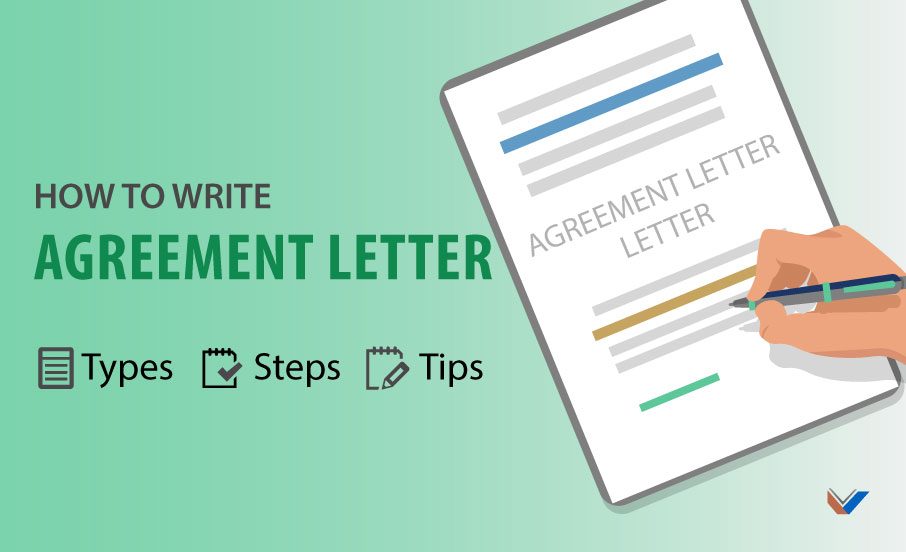Agreement Letter: Types, Samples and How to Write

Negotiation always isn’t as easy as it sounds. Be it your boss, teacher, parents or whoever, we have done some sort of negotiation more or less in our lives. But of course, doing it with your parents is on a different level than negotiating with a potential (or not) business partner. At the occupational level, it needs to be formally memorialized. So if the agreement/disagreement comes in a written form, it becomes a lot easier to avoid misunderstanding and unfortunate, costly litigations. This is where an agreement letter comes to play.
What is an Agreement Letter?
You might have guessed by now when an agreement letter is written. But don’t confuse it with the formal contact between the parties themselves. An agreement letter is the basic version of that contract, the shorter form. It is not as complex as a contract and is more than a handshake after the meeting.
A letter that expresses agreement over a particular issue that has been previously discussed and debated upon, is called an agreement letter. This is written to show that the writer has agreed to the recipient’s opinion/proposal about the issue at hand, they accept their individual responsibilities and that they may now proceed with the dealings to come as a result of this agreement.
Types of Agreement Letters:
An agreement letter can be classified into two prime categories:
- Personal Agreement Letter: These letters are based upon agreements which do not involve business firms, trade, etc. and hence do not serve any so-called commercial purpose. (Sample)
- Business Agreement Letter: These letters are commercially written and include parties of the business, firms, employees, etc. (Sample)
Examples of personal agreement letter include:
- Non-commercial tenancy: roommate agreement letter
- Marital dissolution agreement letter, etc.
Examples of business agreement letter include:
- Non-competition agreement letter
- Debt payment plan agreement letter
- Final settlement agreement letter
- Loan agreement letter
- Non-disclosure/Confidentiality agreement letter
- Commercial tenancy agreement letter
- Purchase and sales agreement letter
- Partnership agreement letter
- Operating agreement letter
- Service Agreement letter, etc.
Samples:
How to Write An Agreement Letter:
An agreement letter must summarize what the prior discussion confirmed. 2 things mark the perfect agreement letter: accuracy and the terms and conditions of the agreement.
Your agreement letter will vary with the nature of your projects. Here, I will tell you what goes in, in a letter written to a freelance writer who has agreed to work for so-and-so company.
Before writing:
Before starting the whole thing, you must be aware of what topic of agreement you are writing about. And this is not just you; the other party also must be aware of what you both are agreeing to. You can meet and discuss, take important notes and the help of an advisor to highlight specific and/or important points of the meeting in your letter.
After all is said and agreed, now is the time to draft. Although it is shorter than the real contract, it should be sufficient and definite enough to carry the main points in it. Since I will tell you here about an agreement letter with a freelance writer, the highlights should be what service he/she should offer, the fees, additional costs for tasks beyond the job responsibilities, the timeline, and the payment method. Begin outlining with these in mind. Other than these, some basic formats and your letter will be ready.
Writing the letter:
- First off, in the center of the page, add the headline: “Letter of Agreement” should be given. In bold, obviously.
- After typing your name, address and mailing address, you can add the date.
- Next, include the information, like, name of the recipient, position, name of the company hiring the freelancer, and company address.
- You can include the subject line right next. It might seem redundant since your headline should specify why you are writing. But your headline can be made clearer in the subject line. If you’re still unsure, you can drop the headline altogether and write a neat subject line specifying the purpose.
- Start with a salutation. Dear Mr./Ms./Mrs. should be just fine.
- The first paragraph should state the reference meeting/discussion based on which the letter has been written. Then state the distinct word of agreement and consent. You can include a sentence or two as to why you think this agreement should work or why it is beneficial. You may or may not write this, no big deal.
- In the next paragraph, you will write the important points that you think should make it to the letter. As a freelancer, you can start with the services you will offer/will be required to offer. You can then include how you’ll be paid: the rate per hour. If you work more or lesser than the required hours, what has to be done in that case, you can include that too. Also, if you are asked to do additional tasks, what shall the pay be then, can be added. The payment method and the timeline of your work should also be written here. Don’t forget to add when the work will start and be over.
- If there are any cancellation clause(s) you can mention that in a small paragraph after this. This is also a good slot to include any confidentiality clause agreed upon by the parties.
- Thank and end with goodwill and a call for contact if need be.
- Add your name and signature and seal the deal.
After Writing:
Make sure you followed the tips.
Tips to Remember:
- Keep the tone formal and the size short to mid-length.
- You can add suggestions to the agreement if you think they’re valid.
- Make it clear that you’re willing to contribute and co-operate.
- Mind the dates and signatures.
- Have it read by legal advisors or do it yourself and check for errors.

